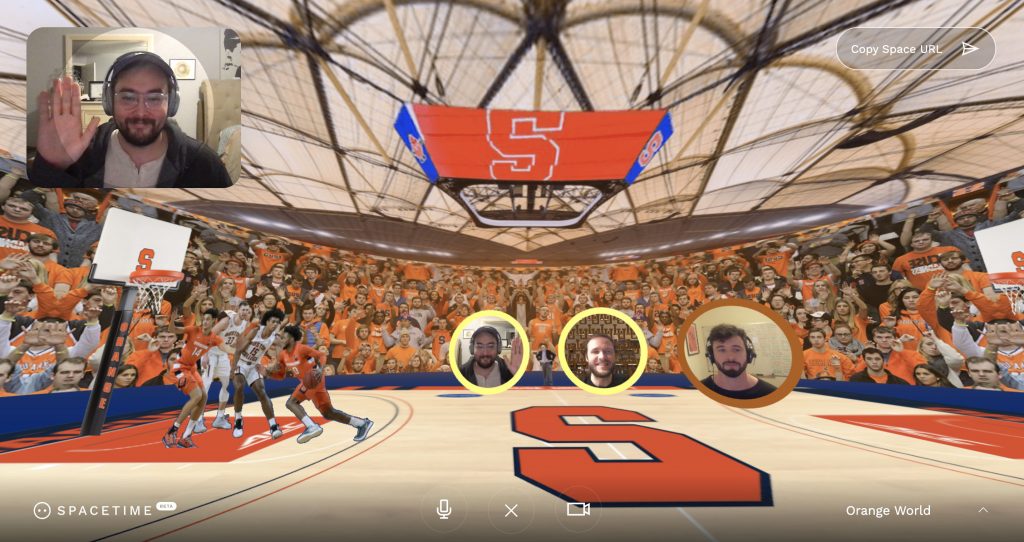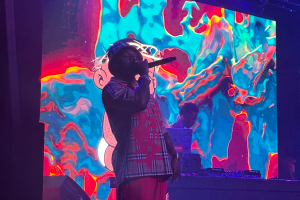SU alumni create new online meeting platform
SU alumni create new online meeting platform

As the world continues to be saturated by conversations regarding Zoom meetings, three developers took it upon themselves to come together and alter the discourse, creating an online meeting space where people would feel more immersed than staring at empty boxes.
SpaceTime, created by SU alumni Drew Osumi and Pat McGowan along with their friend and Lehigh graduate Ryan Hafner, utilizes a mixture of virtual and augmented reality to enable users to meet in virtual 3D worlds and fully interact with one another and their surroundings through personal avatars and unique environments.
“We’ve heard so much about Zoom fatigue, of people getting tired of staring at squares on screens,” said Osumi. “We want to give people the opportunity to walk around in a virtual space but still be at home — sort of like a cross between video chat and video games.”
The SpaceTime software stems from the trio’s self-founded agency, Spinning Rock, which was founded earlier this year. Spinning Rock specializes in the creation of augmented and virtual reality experiences and seeks to create “immersive digital experiences that bring people together.” The idea was to create environments in which consumers could interact with brands, products and events through the mixed reality immersion. They have since partnered with numerous large brands including Nike and Google in conceptualizing and creating experiences featuring their products.
Osumi, McGowan and Hafner were all acquainted with one another prior to coming together to work on these mixed reality projects with Spinning Rock and SpaceTime, each specializing in different creative backgrounds that worked well all together. By remaining close and working together, the trio have been able to make the best out of a year that was otherwise full of doubts and misfortunes and triumph over adversity, now presenting their passion project for the world to see.
“The latest digital applications and experiences are now almost universally built around your device’s camera. The three of us felt that by combining our individual backgrounds in art, code, and photography, it would align well with this shift in technology and culture,” said McGowan. “We formed Spinning Rock to push those boundaries together. With this 3-way marriage, we also considered changing all of our last names to O’McGafner, or McHafnosumi.”
One of Spinning Rock’s first major projects earlier this year was a collaboration with Australian musician Flume. They were able to create an interactive website where people from around the world could paint a 3D version of Flume’s head in real time. This drew inspiration from Reddit’s r/place experiment, in which all users on the platform were able to collaborate with one another in creating one giant piece of art made of smaller pieces. This first project and test of the mixed reality capabilities exceeded their expectations, amassing tens of thousands of collaborators to the art piece, making them ponder how to grow the social aspects of the project from that point.
“We asked ourselves, ‘what if we did something like Reddit r/place did, did it for a musician, and created some sort of music video from that?’” said Osumi. “From there, we kind of thought ‘what could be the next iteration of that project, where people could come together and see similar projects?’”
Spinning Rock’s immediate success with Flume led the trio to dive headfirst into the creation of SpaceTime, with many ideas in place to separate the software from others in a year where video chatting has become the new normal. The software enables users to simultaneously take advantage of virtual and augmented reality in more ways than they may be able to on social media, such as moving around and jumping with the avatar and customizing your appearance with various augmented reality cosmetics. A world-builder tool is currently in development that will enable users to further customize their SpaceTime experience with their own creations.
“We’ve seen with augmented reality face filters that, if you give people the platform to build things on, they will use it however they want,” said Osumi. “We want to give people the tools to build what they want, within reason.”
The trio sought to connect people in the form of video chat using the same principal ideas that led to the creation of the Flume project, and SpaceTime does just that. SpaceTime currently is in its private beta phase and has only a few premade rooms for up to 20 people each that those with the public links are able to join at their leisure. The immersion even goes as far as to include spatial audio, where users will only hear others in their immediate vicinity, making it so that full rooms of users can have different conversations without impeding on others’ experiences. They just recently launched their login system where users are now able to host their own private rooms for events, meetings and gatherings.
As both augmented reality and virtual reality are rather niche development areas, with many aspects of them locked behind expensive equipment, a major component of the creation of SpaceTime was accessibility. Osumi, McGowan and Hafner wanted anyone to be able to use the software on the platforms that they have readily available to them, whether that be on a computer or on a phone, and have the same immersive experience regardless of where they logged in. They worked diligently to ensure that, no matter the browser used, the link to the space would bring people together.
“AR is mostly associated with face filters shared on social media, while VR is associated with gaming and expensive headsets/equipment,” said McGowan. “We want to bring the best parts from each into a more general and accessible and live package – wear an AR costume to a party in a VR world with friends, all from a laptop or phone.”
Right now, SpaceTime’s defining feature is its virtual reality environments that create immersive gatherings, such as concerts and art galleries. Long-term, the team hopes to implement more advanced augmented reality features where people would be able to log in virtually from anywhere and see a replica of a physical store where they would be able to browse and purchase items. Interested consumers would be able to click on the items that they desired, and it would redirect them to the website where they would be able to purchase them.
Syracuse students and faculty interested in trying out the software are now able to register for the beta using their syr.edu emails and enjoy the public spaces that are available to them. Although the software is still in beta, the trio have no doubt that SpaceTime will grow into something exceptional that will continue to captivate all types of audiences, especially as video chatting software continues to be a staple part of daily life.
“Drew, Ryan and I love to build communities and help others do the same online or offline, or even in-line at the grocery store checkout,” said McGowan. “We hope SpaceTime will help people be more connected, creative and productive. And if we can package the elements we’ve seen lead to happy communities into something that anyone can easily access and enjoy, I think we’ve done our job.”





